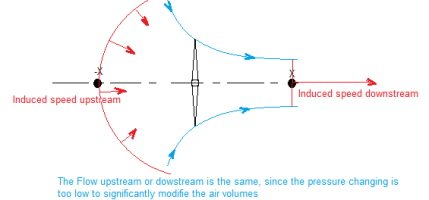[QUOTE="Andino, post:
There are a few jump-start gyroplanes, whose rotor is both driven and provides (brief) vertical lift before sufficient airspeed to maintain autorotation, and their driven rotor does not "push air the wrong direction."
These are de-pitched to over normal RPMs, then the pitch is dumped back in when the blades are at approx. 50% higher rpm than normal cruise.
The momentum and sudden increase of AOA creates thrust as you are saying. It also creates a low pressure area above the rotor, so it too is sucking.
The AOA of the rotor blade as a gyrocopter is low enough to stay in autorotation
I would make a classifying statement to the terms and state that:
Autorotation is a condition where the blades are being driven by the airflow while creating sufficient lift to maintain controlled flight.
That requires a narrow AOA range, too high, they spin backwards, too little, they don't create sufficient lift.
With an AOA that is too negative, I would term it as "Windmilling" and it will produce drag but not sufficient lift because the lift
vectors are rotated forward (Neg. AOA).
This is a simplification, but there is a distinction between a propeller, a gyro copter blade and a windmill blade.
"I used the propeller as an example to illustrate a rotating wing's thrust. A rotating prop makes thrust, but a rotating gyroplane wing does not, and produces instead lift?"
The rotor also produces thrust, but is operating in a low AOA that enables the induced apparent wind over the top of the foil to drive the blade through the air.
Re-read my prior propeller/windmill statement in the earlier post a couple of times, I try to point out the differences, maybe not adequately...
" With the Bernoulli lift metaphor, shouldn't a prop produce very strong suction from the top side of its blades, sucking the aircraft ahead of itself?"
It does, but if you get close enough to notice it, you won't be telling anyone about it and the airplane will need to be hosed off.....
" Nobody thinks of a prop in that way, and we all routinely describe a prop's work as Newtonian thrust. Why not also describe a rotating wing's action as "thrust" (which has the concurrent benefit of lift)? To me, Bernoulli's portion of lift has been overstated, often to such a degree that the palpable downwash of ground effect is minimised if not denied outright. "
I agree with this concept completely, but think the"Thrust" component is also made up from accelerated airflow from over the foil which also creates a low pressure area creating additional lift vectors . As stated before, the high pressure side(Bottom) is providing more lift at low Reynolds numbers (Below 300,000), in the higher Reynolds numbers the upper surfaces multiple lift vectors become increasingly important.
There is a sliding scale, has anyone quantified it?
A lot of people agree with you and I have read multiple articles describing airplane wings as deflecting airflow downwards...
Maybe they are uncomfortable with the word "Thrust"?
"I believe it more accurate to describe a wing's benefit as providing a downward thrust of air vs. a lifting suction, and this is demonstrable regardless of the wing: " prop, rotor, or fixed wing. All wings shove air perpendicularly to its plane. Although that thrust is nearly universally viewed as lift from the wing's other side,"
I haven't seen that as universally viewed in the last 20 years, I have had many discussions with others in the aerospace industry and would say that most would agree with you to some extent.
The Bernoulli theory is persistent because all the older writings adhere to it and they are still very prominent.
Old theories die hard, especially when they are partially true. Look at the Prandtl D lift distribution curve. It has been rediscovered after 70 years and the only designers who exploited, or understood it in the 1930's were the Horten brothers. It is only now starting to be used after being rediscovered about 18 years ago.
Conceptually I agree with this premise ( the 600+ small airplanes I have built operating under RE. 150000. would agree too) and fall on the side of pressure being more important than vacuum, but again, it is a dance between the two, Bernoulli was at least 50% right, although I do not know if he claimed ONLY the low pressure side was lifting, or if it was just a component, but he was not wrong, it just wasn't the whole story...
" I am unemotionally challenging the notion of that. Thust vs. drag? Sure. But, lift vs. weight? Why not thrust vs. weight? We can witness effective thrust of air from props, helicopter rotors, and gyroplane rotors. But not their Bernoulli suction."
You can witness suction, it has been measured, but you are also right and a lot of people have challenged the suction/lift theory for some time now.
You are not alone!
[/QUOTE]

